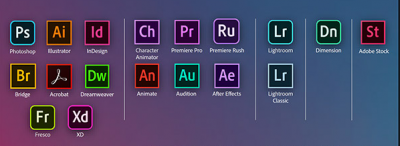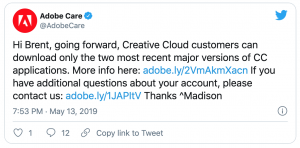Adobe Inc.
Adobe Inc., commonly referred to as “Adobe”, is an international software corporation headquartered in San Jose, California. [1] Adobe offers a line of products and services used by creative professionals, marketers, developers, enterprises, and consumers for creating, managing, delivering, and optimizing compelling content and experiences across personal computers, devices, and media. [2] The company generates revenue by licensing products and services and then providing them to users via a Software-as-a-Service model or a managed services model as well as through term subscription and pay-per-use models. As Adobe continues to expand its products and services, there have been numerous ethical concerns raised about its business practices, including monopolistic practices, misinformation campaigns, version restrictions, and security and data issues.
History

Adobe Inc. was founded as Adobe Systems Inc. in 1982 by John Warnock and Charles Geschke. Adobe’s first product was the PostScript programming language, used by digital printers to structure documents. Adobe quickly became profitable due to an early order by Steve Jobs, the CEO of Apple Computer Inc. Building on the success of PostScript, Adobe entered the consumer software industry in the late 1980s with the release of the now-flagship products Illustrator (a vector-based graphics illustration program) and Photoshop (a widespread image editing program). Both Illustrator and Photoshop quickly gained popularity in their respective fields and lifted Adobe to a dominant position in the creative industry.[4][5]

In the 1990s and 2000s, Adobe continued expanding via both releases of new products like the PDF file format and the Premiere Pro video editing software as well as mergers and acquisitions of competitors such as Macromedia Inc. and Aldus Corporation.[7][8] In the early 2010s, Adobe and longtime partner Apple Inc. had a falling out over Apple Inc.’s refusal to support Adobe’s interactive web application platform Adobe Flash on Apple Inc.’s consumer electronics such as the iPhone and iPad. Apple Inc. CEO Steve Jobs outlined concerns over the security and reliability of Adobe Flash as well as concerns about the business practices of Adobe itself in a viral blog post titled “Thoughts on Flash”.[6]
As the decade progressed, Adobe continued its growth independently and pivoted its business approach. Previously, Adobe had sold its software products in a downloadable one-time purchase bundle called the Adobe Creative Suite. However, in 2013, Adobe switched to a monthly subscription-based model called the Adobe Creative Cloud. This transition marked the first time a major software corporation made such a move and signaled the start of similar transformations across the technology industry in the coming years.[9]
Adobe Creative Cloud
Main article: List of Adobe software
Adobe Creative Cloud is a collection of desktop and mobile apps and services for photography, design, video, web, and UX. It also offers cloud storage and a variety of tutorials and templates for its users. [10]

Creative Cloud Plans & Pricing: [12]
- Individual (Annual plan) - US$52.99/month
- Business (Annual plan) - US$79.99/month
- Students & Teachers (Annual plan) - US$19.99/month
- School & Universities (Annual plan) - US$330.00/year/device or US$34.99/month/user
Adobe Photoshop
Adobe Photoshop is a software that is extensively used for raster image editing, graphic design, and digital art. It makes use of layering to allow for depth and flexibility in the design and editing process. These overlays can support transparency and can also act as masks or filters that can alter underlying images in the layers below them. [13]
Adobe Illustrator
A vector graphics software that allows users to create content from the web and mobile graphics to logos, icons, book illustrations, product packaging, and billboards. [14]
Adobe InDesign
InDesign is a layout and page design software for print and digital media. It is made for publishing projects like newspapers, posters, and other marketing material. InDesign allows content producers to quickly piece together the layouts for multipage magazines and documents. [15]
Adobe Premiere Pro
Premiere Pro is a video editing software for social sharing, TV, and film. Creative tools integrated with other apps and services, and Adobe Sensei helps users craft footage into polished films and videos. [16]
Adobe XD
Adobe XD is a vector-based UX tool for prototyping web and mobile apps. It allows users to visualize the interface and define how all the different parts function and relate to each other without the need to create the entire app. [17]
Adobe Lightroom
Adobe Lightroom is a cloud-based service that allows users to create, edit, organize, store, and share photos across any device. [18]
Adobe Acrobat
Adobe Acrobat is one of the PDF applications that was pioneered by Adobe systems. This software allows users to view PDFs offline and online. It also allows users to create, edit, and print PDF files with ease. [19]
Ethical Concerns
Monopolistic Practices
As a result of its dominant market position in the creative industry, there have been allegations that Adobe engages in monopolistic practices. [20] One such controversy occurred over the cost of Adobe's Creative Cloud service. The cost of Adobe Creative Cloud varies across national borders and is significantly higher in certain countries such as Australia. In 2013, the Australian Parliament launched an inquiry into the pricing of software in Australia by international tech corporations and summoned Adobe executives to a public hearing. Adobe significantly reduced its prices for Australian customers following the hearing.[20]

Another controversy arose over FreeHand, a vector graphics illustration program that directly competed with Adobe Illustrator. FreeHand and Illustrator were the two major players in the digital illustration industry, and each had a large user base.[21] In 1994, Adobe acquired Aldus Corporation, the owner of FreeHand, resulting in Adobe having dominant control over the digital illustration industry. Due to concerns about this new monopoly, the Federal Trade Commission intervened and forced Adobe to sell FreeHand to a competitor.[22] Then, in 2005, Adobe acquired Macromedia Inc., the new owner of FreeHand. The Federal Trade Commission did not intervene with this acquisition, and Adobe proceeded to discontinue the development of FreeHand the following year. This move caused backlash from FreeHand’s users and led to a class-action lawsuit against Adobe in 2011.[21] The lawsuit said that Adobe had violated California and United States antitrust laws through its acquisition of Macromedia Inc. and now held an unfair monopoly over the digital illustration industry. Adobe settled the lawsuit by agreeing to incorporate features of FreeHand into Illustrator.[21]
VoCo
Adobe VoCo is an experimental voice editing software. Using audio files of a human speaker, VoCo is able to generate new audio of that speaker saying words they did not originally speak.[23] VoCo has raised concerns because it has great potential for misuse by malicious actors. VoCo’s audio alteration capabilities could potentially be used as part of smear or misinformation campaigns in order to generate audio where a targeted human speaker is heard saying words they never said.[23] VoCo additionally may be used to generate audio capable of fooling voice-based security systems.[23]
Software Version Restrictions
Adobe's business model in its first three decades largely revolved around distributing licensed software products to customers via CD-ROMS in one-time transactions[24]. This mindset carried over to the Adobe Creative Suite, a comprehensive bundle of Adobe software products, that was released in 2003[24].
However, in 2013, the Adobe Creative Suite software bundle was discontinued and officially replaced by the Adobe Creative Cloud subscription-based service that retailed for $50 per month[24]. The change in business model altered how customers were able to access Adobe products and led to legal action taken in March 2019 by Dolby Labs, a licenser of Adobe software, against Adobe over the management of licensing costs under the new subscription-based business model[25][26][27]. The legal conflict between the two companies over Adobe's Software as a Service (SaaS) transition resulted in another change being made to Adobe’s business model in the following months.

In May 2019, Adobe released a statement stating that customers were only allowed to use the most recent versions of its software products available via Creative Cloud. Furthermore, Adobe claimed that customers who continued to use any previously purchased versions of Adobe software that predated the Creative Cloud would be in violation of Adobe’s terms and conditions and would therefore be liable to lawsuits by third-party companies[25][26][27]. The decree also prohibited the usage of certain software whose inclusion in the Creative Cloud collection was being discontinued and restated the same legal consequences for non-compliance. Though not explicitly specified, media outlets such as Vice Media and Daily Mail stated that the third-party mentioned in Adobe's statement was said to be Dolby Labs due to its recent legal battle with Adobe[25][26][27]. Customer backlash ensued over Adobe’s mandate[27]. Under Adobe’s earlier license-based business model, users who paid for software products were granted a license that gave them ownership over their copy of the software, meaning that the software was the customer’s to keep if he or she purchased it. Under the newer SaaS business model, however, customers had no ownership of any copy of the software, meaning that Adobe had the full ability to restrict usage of certain software or software versions to users[27].
Copyright expert Dylan Gilbert said that Adobe's decision jeopardized customers’ existing projects as newer versions of software may initially be more unstable and susceptible to bugs.[25][26]. Additionally, Gilbert said, “Adobe...has the power to force its customers to upgrade to newer more expensive versions at its whim, which illustrates the undue power and influence...over the lives of consumers”[26].
Adobe Flash Security

The Adobe Flash Player was a piece of software used for viewing multimedia and using interactive web applications.[29] It was first released on January 1, 1996, and has been updated for over 24 years.[30] The age and complexity of this program contributed towards its security vulnerabilities.[30] Through Flash, attackers could take control of a system through many avenues. For example, by having a user open a modified Flash file, an attacker can execute arbitrary code to grant themselves administrative rights to the computer.[31] This could lead to the attacker installing programs, changing data, and creating new users on the target computer.[32] Over time, Adobe patched over 840 code-execution vulnerabilities similar to this, but more vulnerabilities kept being discovered.[33]
The security vulnerabilities behind Flash first gained traction when Steve Jobs refused to support Flash on the iPad and the iPhone in 2010.[6] Over time, more companies began to assess the risk of supporting Flash on their platforms and began a push to make HTML5, an alternative to Flash, more widely available. In 2015, Facebook’s chief security officer, Alex Stamos, made a call for Adobe to announce a date as to when Flash would stop being supported. Many large sites could not afford to abandon Flash and its security vulnerabilities since too many users were familiar with and dependent on the software since it was used on most sites. Setting a deadline for the end of Flash would help these sites know when to shift to an alternative.[34] Two years later in July 2017, Adobe announced that it would only continue supporting Flash until the end of the year 2020.[35] Adobe had chosen to phase out Flash over three years instead of ending support immediately to ensure that businesses and agencies relying on Flash had time to adopt alternatives.[35] In January 2021, Adobe collaborated with technology partners such as Apple, Facebook, Google, Microsoft, and Mozilla to disable Flash by default and to stop the distribution of the software.[36]
Data Breach
On Oct 25th, Comparitech discovered that account details of nearly 7.5 million Adobe CC users were exposed to the public in a database that could be accessed by anyone through the use of a simple web browser. No passwords or security bypassing required.[37] Adobe uses a database to protect these 7.5 million records from Adobe creative cloud users. However, the cache of this database has nearly no protection and allows anyone to access the client information. [38] For efficiency's sake, Adobe uses decentralized management whereas they did not have enough security measures.[39]
This is not the first time the company has had such an accident. According to reports, a previous data leak at the company forced 38 million customers to reset their passwords. In addition, the company's flash products are also notorious in terms of security, so that most browsers will block flash by default.[40]
References
- ↑ Adobe Inc Office Locations https://www.adobe.com/about-adobe/contact/offices.html Retrieved April 20, 2021
- ↑ Adobe Revenue 2006-2021. Macrotrends. https://www.macrotrends.net/stocks/charts/ADBE/adobe/revenue
- ↑ Cassidy, M. (2009, December 3). Cassidy: More than business for Adobe’s founders. The Mercury News. https://www.mercurynews.com/2009/12/03/cassidy-more-than-business-for-adobes-founders/
- ↑ Yegulalp, S. (2010, April 12). Adobe Creative Suite: The history. Computerworld. https://www.computerworld.com/article/2517120/adobe-creative-suite--the-history.html
- ↑ Dormehl, L. (2021, February 19). Today in Apple history: Photoshop debuts as a Mac exclusive. Cult of Mac. https://www.cultofmac.com/685433/today-in-apple-history-photoshop-debuts-as-a-mac-exclusive/
- ↑ 6.0 6.1 6.2 Miller, P. (2010, April 29). Steve Jobs publishes some 'thoughts on Flash'... many, many thoughts on Flash. Engadget. https://www.engadget.com/2010-04-29-steve-jobs-publishes-some-thoughts-on-flash-many-many-thou.html
- ↑ Yegulalp, S. (2010, April 12). Adobe Creative Suite: The history. Computerworld. https://www.computerworld.com/article/2517120/adobe-creative-suite--the-history.html
- ↑ Dormehl, L. (2021, February 19). Today in Apple history: Photoshop debuts as a Mac exclusive. Cult of Mac. https://www.cultofmac.com/685433/today-in-apple-history-photoshop-debuts-as-a-mac-exclusive/
- ↑ 9.0 9.1 Moon, M. (2019, May 14). Adobe warns Creative Cloud users with older apps of legal problems. Engadget. https://www.engadget.com/2019-05-14-adobe-creative-cloud-older-apps-warning.html
- ↑ Adobe Inc Creative Cloud. https://www.adobe.com/creativecloud.html Retrieved April 19 2021
- ↑ Watson, J. (2019 Nov 14). Compare Versions: What's New in Adobe CC 2020 vs. Older Releases https://prodesigntools.com/whats-new-adobe-cc-2020.html Pro Design Tools Retrieved April 19 2021
- ↑ Adobe Inc Creative Cloud: Plans https://www.adobe.com/creativecloud/plans.html Retrieved April 19 2021
- ↑ Techopedia Inc Adobe Photoshop: What Does Adobe Photoshop Mean? https://www.techopedia.com/definition/32364/adobe-photoshop Retrieved April 19 2021
- ↑ Adobe Inc Adobe Illustrator https://www.adobe.com/products/illustrator.html?promoid=RYGDN24L&mv=other Retrieved April 19 2021
- ↑ Austin, (2020, October 24). What Do All of the Adobe Programs Do? GroovyPost https://www.groovypost.com/reviews/adobe-programs-explained/ Retrieved April 19 2021
- ↑ Adobe Inc Adobe Premiere Pro https://www.adobe.com/products/premiere.html Retrieved April 19 2021
- ↑ May, Tom. (2020, November 12). Adobe software list: Which apps do you need? Creative Blog https://www.creativebloq.com/features/adobe-software-list Retrieved April 19, 2021
- ↑ Adobe Inc Adobe Photoshop Lightroom https://www.adobe.com/products/photoshop-lightroom.html Retrieved April 19 2021
- ↑ Williams, Elise. (2020, December 21). What is Adobe Acrobat - Things You Need to Know? Wondershare https://pdf.wondershare.com/pdf-software-comparison/what-is-adobe-acrobat.html Retrieved April 19, 2021
- ↑ 20.0 20.1 Toor, A. (2013, February 12). Adobe drops the price of Creative Cloud in Australia ahead of a government inquiry. The Verge. https://www.theverge.com/2013/2/12/3979690/adobe-reduces-price-of-creative-cloud-in-australia-ahead-of-inquiry
- ↑ 21.0 21.1 21.2 21.3 Smith, E. (2019, March 18). Is Adobe’s Creative Cloud Too Powerful for Its Own Good?. Vice. https://www.vice.com/en/article/3kgw83/is-adobes-creative-cloud-too-powerful-for-its-own-good
- ↑ Bangeman, E. (2006 May 31). Adobe officially kills GoLive and Freehand?or do they?. Ars Technica. https://arstechnica.com/uncategorized/2006/05/6954/
- ↑ 23.0 23.1 23.2 Lardinois, F. (2016, November 3). Adobe’s Project VoCo lets you edit speech as easily as text. TechCrunch. https://techcrunch.com/2016/11/03/adobes-project-voco-lets-you-edit-speech-as-easily-as-text/
- ↑ 24.0 24.1 24.2 How Adobe Became a Successful $95 Billion Saas Company. (n.d.). Product Habits Blog. https://producthabits.com/adobe-95-billion-saas-company/
- ↑ 25.0 25.1 25.2 25.3 Gallagher, W. (2019, May 13). Adobe warning of legal problems if subscribers keep using old versions of Creative Cloud apps [u]. Apple Insider. https://appleinsider.com/articles/19/05/13/adobe-warning-of-legal-problems-if-users-keep-using-old-versions-of-creative-cloud-apps
- ↑ 26.0 26.1 26.2 26.3 26.4 Bode, K. (2019, May 14). Adobe Tells Users They Can Get Sued for Using Old Versions of Photoshop. Vice. https://www.vice.com/en/article/a3xk3p/adobe-tells-users-they-can-get-sued-for-using-old-versions-of-photoshop
- ↑ 27.0 27.1 27.2 27.3 27.4 Pero, J. (2019, May 15). Outrage after Adobe says customers using an older version of Photoshop may be SUED if they continue - even though they paid for the software. Daily Mail. https://www.dailymail.co.uk/sciencetech/article-7034239/Outrage-Adobe-says-customers-using-older-version-Photoshop-SUED-continue.html
- ↑ Adobe Flash Player. (n.d.). Retrieved April 09, 2021, from https://get.adobe.com/flashplayer/about/
- ↑ Internet safety: Should I still use adobe flash player? (n.d.). Retrieved April 08, 2021, from https://edu.gcfglobal.org/en/internetsafety/should-i-still-use-adobe-flash-player/1/
- ↑ 30.0 30.1 McElhearn, K. (2020, December 29). The history of Adobe Flash Player: From multimedia to malware. Retrieved April 08, 2021, from https://www.intego.com/mac-security-blog/the-history-of-adobe-flash-player-from-multimedia-to-malware/
- ↑ Security alert: Adobe Reader & acrobat 9 and Flash Player 10 security update - information Security office - computing services - Carnegie Mellon University. (n.d.). Retrieved April 08, 2021, from https://www.cmu.edu/iso/archive/2008/november/security-alert-adobe-readr-and-acrobat-9-and-flash-player-10-security-update.html
- ↑ A vulnerability in adobe flash player could allow for arbitrary code execution (apsb20-58). (n.d.). Retrieved April 08, 2021, from https://www.cisecurity.org/advisory/a-vulnerability-in-adobe-flash-player-could-allow-for-arbitrary-code-execution-apsb20-58_2020-139/
- ↑ Continued use of adobe flash invites compromise. (n.d.). Retrieved April 08, 2021, from https://media.defense.gov/2019/Sep/25/2002186834/-1/-1/0/CSA%20-%20CONTINUED%20USE%20OF%20ADOBE%20FLASH%20INVITES%20COMPROMISE.PDF
- ↑ Vincent, J. (2015, July 13). Facebook's new chief security officer wants to set a date to kill Flash. Retrieved April 08, 2021, from https://www.theverge.com/2015/7/13/8948459/adobe-flash-insecure-says-facebook-cso
- ↑ 35.0 35.1 Warren, T. (2017, July 25). Adobe will finally kill Flash in 2020. Retrieved April 08, 2021, from https://www.theverge.com/2017/7/25/16026236/adobe-flash-end-of-support-2020
- ↑ Adobe Flash support ending - updates and alternatives to flash. (2021, February 26). Retrieved April 08, 2021, from https://www.awebco.com/blog/adobe-flash-support-ending/
- ↑ David J. Crewe. (2019, November 20). Adobe Data Breach Exposes Nearly 7.5 Million Creative Cloud Accounts To Public. Photography News. https://www.slrlounge.com/adobe-data-breach-exposes-nearly-7-5-million-creative-cloud-accounts-to-public/#:~:text=Adobe%20Data%20Breach%20Exposes%20Nearly%207.5%20Million%20Creative%20Cloud%20Accounts%20To%20Public,-David%20J.&text=Recently%20Adobe%20accidentally%20allowed%20private,of%20scams%20and%20hacking%20attempts.
- ↑ Matt Barrett. Centralized and Decentralized Management Explained. Personal Finance Lab. https://content.personalfinancelab.com/finance-knowledge/management/centralized-and-decentralized-management-explained/?v=c4782f5abe5c
- ↑ Samantha Schwartz. (2019 May 31). Playing by the rules: How Adobe centralized its data management. Ciodive.https://www.ciodive.com/news/playing-by-the-rules-how-adobe-centralized-its-data-management/555721/
- ↑ Catalin Cimpanu. (2019, October 26). Adobe left 7.5 million Creative Cloud user records exposed online. ZDnet. https://www.zdnet.com/article/adobe-left-7-5-million-creative-cloud-user-records-exposed-online/
